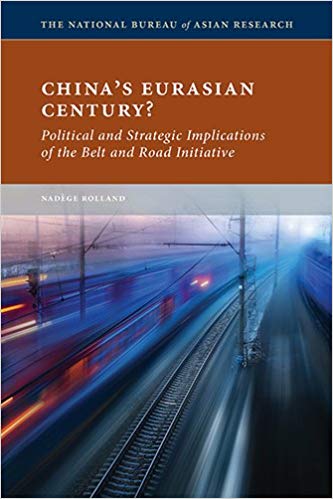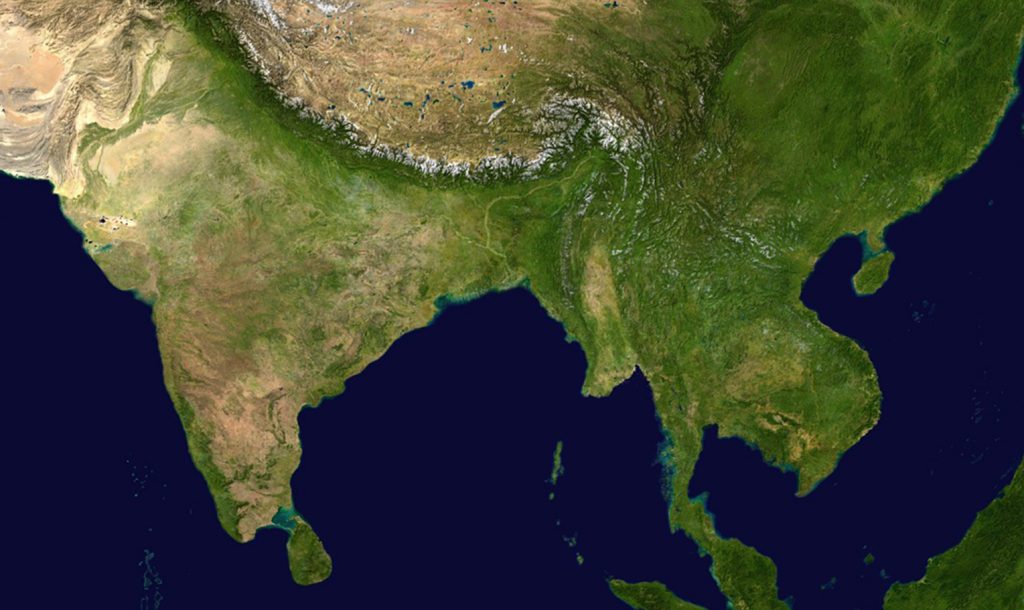 What is the true meaning of China’s “Belt and Road”, the foreign policy initiative (BRI) launched in 2013 by President Xi Jinping, that has been debated since then in academic, media, and policy-making circles? What are its origins? What are the main drivers behind it? And how should the United States react to Beijing’s new charm offensive? To all these questions reply China’s Eurasian Century? Political and Strategic Implications of the Belt and Road Initiative, a two hundred-page comprehensive account of BRI written by Nadège Rolland, a senior fellow for political and security affairs at the National Bureau of Asian Research (NBR), and formerly a senior advisor to the French Ministry of Defense.
What is the true meaning of China’s “Belt and Road”, the foreign policy initiative (BRI) launched in 2013 by President Xi Jinping, that has been debated since then in academic, media, and policy-making circles? What are its origins? What are the main drivers behind it? And how should the United States react to Beijing’s new charm offensive? To all these questions reply China’s Eurasian Century? Political and Strategic Implications of the Belt and Road Initiative, a two hundred-page comprehensive account of BRI written by Nadège Rolland, a senior fellow for political and security affairs at the National Bureau of Asian Research (NBR), and formerly a senior advisor to the French Ministry of Defense.
The six chapters of the book can easily be divided in four parts: the historical context of Silk Road projects prior to China’s BRI (Ch. One), the content and the drivers of BRI (Ch. Two and Three), the vision behind it and the obstacles to its implementation (Ch. Four and Five), and the political and strategic implications of BRI (Ch. Six).
Chapter one is indeed one of the most original contribution to the fast-expanding literature on BRI, as it shows how the idea advanced by China to connect the landmasses of Eurasia through roads, railways, and pipelines is nothing new. After the demise of the Soviet Union in the early 1990s, the West had to deal with new independent countries in Central Asia and in the Caucasus: located far from main global trade routes, and with a decrepit—if existent at all—industrial structure, increased connectivity seemed to be the right way to transform into proper markets what looked like more peripheral ‘spaces’ with no attractiveness for investors. The books details three multilateral initiatives: the Asian Multilateral Land Transportation Infrastructure Development Program (within the UN institutional framework), the Transport Corridor Europe-Caucasus-Asia initiated by the EU, and the Central Asia Regional Economic Cooperation, a regional initiative led by the Asian Development Bank.
The author delves also into unilateral projects. We then discover—quite surprisingly—that Japan has been one of the most active countries in the region, followed by Korea with its “Iron Silk Road” aimed at connecting Seoul and Paris by railways. In particular, Japan mostly directed its aid to South-East Asia to build “heart to heart” relations—a smart choice, considering the importance that this part of the world would soon be gaining as a destination of China’s investments. In the 1990s, also the United States was looking at Central Asia, trying to support development, democracy and human rights in these countries. For four times between 1997 and 2006, the Silk Road Strategy Act was introduced in Congress, but it was never passed by the Senate. When Hillary Clinton launched her “New Silk Road” project in 2011, by then the real American focus was on integrating Afghanistan in the region – but a lack of financial commitment to anything that was not related to Afghanistan meant that the project really did not live up to its potential. Central Asia had already caught the Chinese attention before 2013, at least since 1999-2000, when Beijing launched the “open up the West” (xibu da kaifa) policy, aimed at bringing growth to backward Western provinces.
From there, Beijing launched cross-border infrastructure building initiatives, like the Greater Mekong Subregion (GMS) Economic Cooperation (for the enhancement of connectivity among Cambodia, China, Laos, Myanmar, Thailand and Vietnam), the Pan-Beibu (Greater Mekong) Gulf Economic Cooperation (a project launched by Guanxi provincial government and supported by the ADB, involving South-East Asia), and the New Eurasian land bridge (creating a new transcontinental railway corridor from China’s coastal provinces to Rotterdam). Therefore, in those years, China was socialised to multilateral venues and for a that eventually helped Beijing to give shape to its project. For instance, by designing with ASEAN countries the three vertical and two horizontal transportation corridors through the GMS—connecting Kunming to Myanmar, Thailand and Vietnam, linking the Andaman Sea and the port of Da Nang and major towns across the Southern part of the GMS—and working closely with the Asian Development Bank, Beijing for sure went through a learning process which eventually allowed China to establish the new Asian Infrastructure Investment Bank (AIIB), its most successful experiment in multilateralism. The general impression one gets from reading this chapter is that China’s projects have been the most successful ones, even though the challenges in the region are huge: “Across Eurasia, rivalries among neighbors, the lack of high-level commitment, elites’ reluctance to give up revenue generated by illicit trafficking, and their fear that opening their country to foreign passage will loosen their grip on power constitute the biggest roadblocks to transcontinental interconnectivity” (p. 41).
Enter BRI in Chapter Two, significantly entitled “The Belt and Road Initiative: Bigger, Bolder, Better?”. Rolland argues that what sets apart BRI from all previous initiatives is that Xi Jinping’s speeches (in Astana and in Jakarta respectively) launching the Silk Road Economic Belt (in Eurasia) and the 21st Century Maritime Silk Road (from coastal China to the Mediterranean through the Malacca Strait and the Indian Ocean) delineate an ambitious overarching vision that goes beyond single projects or ventures. Although BRI—even for many Chinese scholars—is “an amorphous and ambiguous construct” (p. 45), it clearly aims at projecting China’s influence and money to Eurasia. The section of the chapter devoted to financial instruments in support of BRI is particularly enlightening. New institutions have been established, both at multilateral (the AIIB, and the New Development Bank), and at domestic level (the Silk Road Fund), whose short history the author recalls. Policy banks like China Development Bank and Export-Import Bank of China are also strongly financing BRI projects.
Probably the most interesting section in the chapter is represented by a summary of all intellectual voices encouraged (or, better, instructed) by the central leadership to study and analyse BRI while at the same time engaging in discussion foreign experts—a smart move, as academics, commentators, and policy-makers from all over the world started to offer free consultancy to Beijing in order to fill of content “the amorphous construct”. The author duly notices that “more than 8,400 BRI-related articles were published by Chinese scholars in 2015, compared with 492 in 2014” and that “over one hundred dedicated BRI research institutes and centres have also been founded in Chinese universities” (p. 62). Needless to say, most of these centres are government-funded. Since 2014, all sorts of national and international events, conferences, symposia, and seminars have had BRI as their convening theme. After all, the author concludes, BRI is a long-term project with a coherence, not always easily understood by the West: “If BRI had been marketed by a Western advertising firm, it might have been given a more forward-looking label like ‘China-Asia connectivity 2050’” (p. 90).
In fact, the economic and security rationales behind are profound, and to then Rolland dedicates the entire third chapter. The Great Recession in 2007–08 and President’s Obama “Pivot to Asia” in 2011 were the main events that convinced the Chinese leadership to change their approach in foreign policy. On the one hand, reduced growth rates in the West were threatening the sustainability of China’s export-led economic model, while on the other hand the American renewed interest towards the Asia-Pacific raised “encirclement” fears in Beijing. Thus, BRI became a convenient way to re-ignite China’s growth through the creation of new markets (BRI countries account for 63% of world population), to sell abroad the industrial overcapacity of many State-Owned Enterprises (SOEs), and also to internationalise the reniminbi. In particular, “global champions” are at the core of China’s economic projection, with evident strategic implications: “BRI is meant to promote their business activities abroad and help them expand their international clout, but it also uses SOEs as the political leadership’s strong arm to gain leverage and influence in host countries” (p. 102).
It is actually the top-down, state-led nature of BRI that makes the author skeptical about pattern changes in China’s economic growth—rather, BRI seems just to postpone the day of reckoning for the Chinese economy. In strategic terms, first of all China wants clearly to replicate its experience abroad, as Beijing thinks that economic development will bring peace and stability to BRI regions, starting from its own Xinjiang’s restive province (this vision of course totally disregards religious, cultural and linguistic factors in people’s contestation of political space). Second, with BRI China aims at securing energy resources, by diversifying its energy portfolio and suppliers. Third, BRI represents a chance to strengthen Beijing’s charm offensive to its neighbors, especially in South-East Asia. Academic institutions in the Yunnan province, for instance, should—in the leadership’s intention—become the attraction pole of students coming from Southeast Asia. Maybe the author’s claim that BRI is “a response to existential challenges posed by the United States” (p. 119) is somehow overstated, but for sure the idea that the (now aborted) U.S. pivot to Asia contributed to generate an adequate response in Beijing cannot easily be dismissed.In this sense, beyond representing a defensive move, BRI reflects also a more active posture at the global level, as it is clearly outlined in chapter four. BRI is based on such pillars like “a community of common destiny”, “win-win co-operation”, and “collective modernization” that might sound like empty slogans, but that signal the willingness to do things in a distinct way – a globalization with Chinese characteristics. Inserted into Xi Jinping’s narratives of the ‘China dream’ and ‘the rejuvenation of the nation’, BRI is a perfect offer to the world of public goods orchestrated by China, and suited to China’s interests.
One of the main merits of the book is the systematisation of debates among intellectuals and policy-makers, and a clear example is to be found here, when the author gives evidence of China’s self-reflection on its status as a great power. The evolution of this debate has reached the conclusion that China’s power is different from Western imperialism: it is exceptional (ask Americans about themselves), benevolent, peaceful, and respectful of differences (ask Tibetans). It might be true that “beyond the broad concepts of inclusiveness and “win-win” that are presented as the fundamental features of the Silk Road Spirit, there is no clear definition of what these principles might look like” (p. 137), but nonetheless Beijing is developing an alternative (Sinocentric) order, that does need to directly challenge the liberal order (like the China-threat school would make us believe).
As China recreates its “all under heaven” tributary system—a system requiring the recognition of China’s primacy—a question comes to the fore: “which ‘modern Chinese values’ does Xi have in mind that could provide the basis for shared beliefs and norms across the region?” (p. 139). What norms and regimes will China promote in Eurasia? The speculative dystopic picture portrayed in the book of a landmass governed by non-accountable (in liberal democracy terms) regimes reporting to China, that control their apparently-free populations through well-connected digital networks, reveals that far from representing “China’s uniqueness”, this framework just replicates—in a fashion familiar to all empires—“general effort to discredit Western ideas and institutions while presenting China’s model as an alternative—and implicitly superior—political and economic path” (p. 140). Even though this scenario might look scary, the danger is real, as “China incrementally drew into line the most advanced industrial countries, including Japan, South Korea, Australia, and the nations of Western Europe, by offering them more financial and economic incentives” (p. 146). Can money buy values?
The book draws on many interviews and private talks the author has had with academics and officials in China, and this is also the strength of chapter four, which identifies four main obstacles to the successful implementation of BRI. First, the lack of China’s experience in the region, combined with Eurasia’s diversity, requires a ‘knowledge’ and co-ordination effort among experts and different bureaucracies in charge of BRI. As we have seen, studies and analyses on BRI abound, but the nature of the regime could prevent critical voices from speaking out: “in a country where whistle-blowing can be dangerous, it may be difficult for analysts […] to report the truth […]” (p. 156).
Second, many projects under BRI umbrella are simply not economically viable or profitable (ask Chinese economists about the economic logic of investing in Pakistan), and China must find a way to mitigate risks. Third, great powers and local governments alike are not at ease with China’s activism, and they might sabotage the plan, or at least to hedge the bets. South –East Asia is a clear case in point: no matter how much ‘soft power’ or ‘money diplomacy’ Beijing irradiates, the more China talks about ‘win-win’, the more ASEAN countries reach out to the U.S. security guarantee (ask Vietnam). For these countries, the risk of becoming a satellite of China is simply too high to ignore. To complicate matters, South-East Asia finds itself increasingly at the center of a “great game of influence” that involves also – through the newly-resurrected Indo-Pacific Policy – Japan and India, in a clear attempt to create an alternative “arc of influence” centred on liberal democracies.
Fourth, BRI spans across one of the most chaotic regions of the world, where sectarian conflicts, terrorism, and organized crime pose an extreme challenge to potential investors: in fact, security risks “could draw China into local quagmires” (p. 167). With the multiplication of Chinese economic interests abroad, can Beijing’s traditional policy of non-interference in internal affairs still hold? Will co-ownership (with local capital) guarantee against any drawbacks?
Chapter six concludes that BRI is “a grand strategy that seems China’s vision for itself as the uncontested leading power in the region” (p. 177), but since power naturally brings contestation, it remains to be seen—all factors being equal—how BRI countries will receive China’s offer, and how Beijing will find a balance between defense of national and Party interest and promotion of public goods. In the end, the author asks herself if “China will succeed where the West has failed”, and the answer is a sounding “yes, possibly”, as strongmen around the world will feel emboldened by Beijing’s embrace, and as China—with its abundant flow of money—succeeds in a driving “a wedge” between America and Europe, and between EU member states themselves (ask Greece). America has a choice: either to engage China on BRI, socialising Beijing to liberal rules as it has done since the 1990s, or to “held Beijing to account”, by (a) looking closely at single projects and initiatives, and their consequences in terms of environment sustainability, financial viability, and social and political fragmentation, and (b) engaging countries along BRI, in order not to leave them to their own devices vis-à-vis China. Since the first strategy has not fully paid off, the author seems to prefer the second option. Thus, the book concludes with a sort of ‘wake-up call’ for the West. But wouldn’t this approach increase confrontation, rivalries and conflicts?
Even though sometimes betraying its American perspective (with a European tinge), and overlooking a bit Beijing’s infrastructure projects in South-East Asia, China’s Eurasian Century? contains a wealth of fact, ideas, and debates that make it the definitive account of BRI so far (probably together with Richard T. Griffiths’s Revitalising the Silk Road), and the starting point for any scholar willing to undertake further research on it, or for any policy-maker trying to formulate possible responses to China’s charm offensive. If one has to find a small weakness in the book—hard as the exercise is—maybe the author should have devoted a bit more space to the maritime dimension of BRI and its effects on the Mediterranean, with huge implications on ports facilities and sea trade lanes. For the rest, Rolland starts the journey on the road to the Belt and Road, she crosses the land and reaches the top of the hill. From here on, it is up to the reader thinking of what path should be taken for a true “win-win” co-operation.
 Facebook
Facebook  Twitter
Twitter  Soundcloud
Soundcloud  Youtube
Youtube  Rss
Rss 
 Giuseppe Gabusi is Assistant Professor of International Political Economy and Political Economy of East Asia at the University of Turin. He is also one of the co-founders of T.wai, Torino World Affairs Institute, where he is the Head of Program ‘Changing World Politics’. He has been visiting research fellow at the Australian National University, Canberra, and at the East-West Center, Honolulu. His research interests include China’s political economy, Myanmar’s transitions, foreign policy analysis, the developmental state, and regionalism in the Asia-Pacific. He is a member of the editorial board of the online journal OrizzonteCina and editor of RISE, an online journal on contemporary South-East Asia.
Giuseppe Gabusi is Assistant Professor of International Political Economy and Political Economy of East Asia at the University of Turin. He is also one of the co-founders of T.wai, Torino World Affairs Institute, where he is the Head of Program ‘Changing World Politics’. He has been visiting research fellow at the Australian National University, Canberra, and at the East-West Center, Honolulu. His research interests include China’s political economy, Myanmar’s transitions, foreign policy analysis, the developmental state, and regionalism in the Asia-Pacific. He is a member of the editorial board of the online journal OrizzonteCina and editor of RISE, an online journal on contemporary South-East Asia.